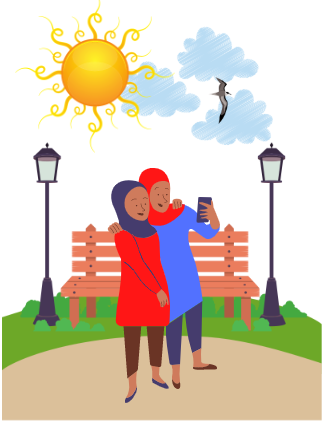I/ii - Virtual Teams: Space Management Across Different Cultures
Distance has the same effect on the mind as on the eye
- Samuel Johnson, The History of Rasselas, Prince of Abissinia
***
The recent Coronavirus outbreak compelled the majority of organizations around the world to roll out mandatory remote working for their staff: while some employees are not new to remote working, for many others this is an unusual scenario that will pose a number of challenges of different nature (mostly infrastructural and behavioural).
A research on “How to Manage the Loneliness and Isolation of Remote Workers” conducted by Gallup in 2019 found that “remote work causes loneliness and isolation”: remote workers “can't get the materials or information they need, they think their achievements or development are ignored, they feel cut off from the business”.
Interactions happening from behind a screen are distancing: in face-to-face interactions personal space and the distance at which people interact are both fundamental components of non-verbal communication, that must be adapted to virtual environments for those working remotely.
What are the main the main challenges faced by virtual workers with regard to distance and space management?
For a start, it can be difficult to establish trust when face-to-face interactions and opportunities to build rapport are not an option. Communication can also be difficult when people cannot pick up the subtle cues - body language, facial expression - typical of non-verbal communication (written messages in particular can be easily misunderstood), share eye-contact, or engage in bonding activities - such as office debate - together. Furthermore, human beings tend to be territorial and emotionally attached to spaces.
In this first article about space management and spatial behaviour across different cultures we are going to introduce the concepts of “space” and “territory” in order to understand how space and distance affect personal interactions and group dynamics in the workplace.
Proxemics, “the spatial dimension of non-verbal behaviour”
According to anthropologist E. T. Hall, proxemics is "the spatial dimension of non verbal behaviour", the study of man's perception and use of space : social research suggests that people from different cultural backgrounds do not share the same preferences in relation to space management (what may appear as "normal" behaviour to some of us may represent a violation of a social norm for another individual), and that sense of space relates to four different zones, defined by both physical distance and level of discomfort: Intimate Space, Personal Space, Social Space, Public Space.

Fig.1: Hall’s Personal Reaction Bubbles
Public space requires no physical- or direct eye-contact. Shopping malls, stations, airports, stages, side-walks are designed to keep this type of distance.

Social space is the preferred distance for business dealings and interactions with people we are not very close to.

Personal space is reserved to interactions among family members and close friends. Physical contact is possible.

Intimate space surrounds our body and it's meant for interactions with our loved ones that involve physical contact (hugging, whispering, touching, etc).

Researchers Lyman and Scott defined territoriality as "the need of individuals and groups to claim some geographical area as their own" and sustained that we can distinguish four different types of territories (the difference between territory and personal space, at times referred to as "portable territory", is that the latter is something individuals "carry around" with them):
- PUBLIC TERRITORIES: most people have freedom of access, but not necessarily of action. Appropriate behaviour is expected and occasionally enforced by the law;
- HOME TERRITORIES: people have relative freedom of behaviour and experience a sense of control over the area (note: in some occasions public and home territories may overlap, when a public space is used as a home territory by a specific sub-group of people);
- INTERACTIONAL TERRITORIES: all the areas where social interactions may occur (eg, parties), characterized by both mobility and fragility: conversations may move from a place to another, interrupt and resume at a later stage. Access to these territories is granted to those who understand the implicit rules put in place by the existing members of the group involved in the interaction;
- BODY TERRITORIES: the most private territory belonging to an individual.
How do the concepts of "space" and "territoriality" fit into today's global workplace, considering both the traditional territorial modification (with conversations often happening between people based in different countries nowadays) and the time needed for the parties involved to assimilate and adapt to change?
Space management affects the relationships among co-workers, between suppliers and clients, it's strictly correlated with power dynamics ("power holders" are usually afforded a larger personal space and a more desirable territory in comparison with subordinates): what can companies do to ensure that space in the workplace is managed correctly, with a view to achieving the best possible outcomes with regard to employee engagement and satisfaction?
Contact v No-contact Cultures: an overview
According to Hall's theory, cultures fall into two basic groups: contact (physical touching is a way to establish interpersonal relationships) and no-contact (physical touching between acquaintances is frowned upon).
Contact Cultures
On average (to varying extents), physical contact during conversations is considered "normal behaviour for cultures based in the Middle East, in Latin America, in Africa, in Southern Europe.
In these areas the physical distance between individuals is relatively small in comparison to the distance maintained between members of no-contact cultures.

No-contact Cultures
On average (to varying extents), in Northern- and Eastern Europe, in Northern America, and in most Asian countries, physical contact in social situations is considered awkward and inappropriate.
In these areas physical distance between individuals tends to be greater in comparison to the distance maintained between members of contact cultures.

It's worth noting that while belonging to either a group or the other gives no indication about territoriality tendencies (for instance, the Japanese are both no-contact and low-territoriality), cultures characterized by high territoriality are usually low-context and monochronic and vice-versa.
People with low territoriality tendencies have less ownership of both space material belongings and are usually more ready and willing to share with others, while boundaries are more important to people with high territoriality tendencies, who display a greater concern for "ownership" and do not respond particularly well to personal closeness.
The relation between space and time
Monochronic Time (Linear/Sequential)
Man-made units of time measurement. It presupposes the compartmentalization of tasks and relationships.

Private Space
Given the option, private offices would be preferred in order to avoid distractions and interruptions.

Polychronic Time (Cyclical/Synchronous)
Priorities are ever changing to fit situations, deadlines are not a major concern, relationships are more important than tasks.

Shared Space
Shared spaces are preferred since, by separating individuals from one another, private space "disrupts" the flow of information.

***
As you can easily conclude, dear readers, relationships mediated by technology can be utterly challenging: in the next article we will explore the factors - spatial, social, cultural, etc. - that influence the distance between team members in the workplace.
SOURCES:
Burgoon, J. K., Stacks, D. W., & Burch, S. A. (1982). "The role of rewards and violations of distancing expectations in achieving influence in small groups". Communication, 11, 114-128
Gallup, Online: https://www.gallup.com/workplace/268076/manage-loneliness-isolation-remote-workers.aspx
Jarvenpaa, S. L., & Leidner, D. E. (1999). Communication and trust in global virtual teams. Organization Science, 10(6), 791–815. https://doi.org/10.1287/orsc.10.6.791
Hall, E. T. (1959). “The Silent Language”. New York: Doubleday
Hall, E.T. (1966). "The Hidden Dimension", New York, NY: Doubleday
Hall, Edward T. 1963. “A System for the Notation of Proxemic Behavior.” American Anthropologist (Blackwell Publishing Ltd) 65 (1548-1433): 1003--1026
Hall, E. T. (1976). "Beyond culture". New York, NY: Doubleday
Hall, E.T. (1990). "Understanding Cultural Differences: Germans, French and Americans", New York: Doubleday
Hofstede, Geert H. (1997). "Cultures and Organizations: Software of the Mind (second ed.)". New York: McGraw-Hill
House, R. J., Hanges, P. J., Javidan, M., Dorfman, P. W., & Gupta, V. (2004). "Culture, leadership, and organizations: The GLOBE study of 62 societies". CA: Thousand Oaks
House, R., Javidan, M., Hanges, P., & Dorfman, P. (2002). "Understanding cultures and implicit leadership theories across the GLOBE: An introduction to project GLOBE".Journal of World Business, 37(1), 3–10. New York: Harper Collins
Lyman, S. M., & Scott, M. B. (1967). "Territoriality: A neglected sociological dimension". Social Problems, 15(2), 236-249 - https://doi.org/10.2307/799516
Maznevski, M. L. and Chudoba, K. M. . “Bridging space over time: Global virtual team dynamics and effectiveness”. Organization Science, 2000, 11(5), 473-492

